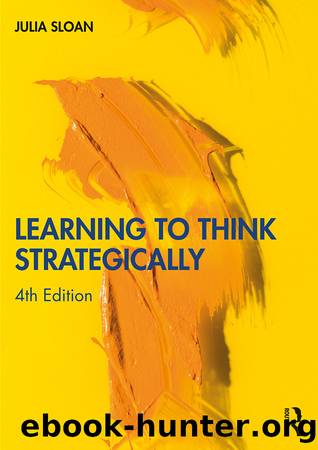Learning to Think Strategically by Sloan Julia;

Author:Sloan, Julia;
Language: eng
Format: epub
Publisher: Taylor & Francis Group
Published: 2019-08-22T00:00:00+00:00
Learning to dialogue
The critical dialogue process lends itself well to informal learning. Critical dialogue can happen constructively anywhere and at any time. A young technology executive said:
I just draw on my own experience, and I’ve also tried to learn from others’ [experience]. I guess I’m just curious, for better or worse (laughter), and it’s so important to talk to a lot of people – learn from them this way. People are happy to tell you their experiences. Nobody taught me, I just learned things, you know … my life experiences were all I ever had.
More structured and formal approaches to facilitating critical dialogue can also be useful. In structuring a strategic dialogue, there are a couple of small details that I find helpful for ensuring that it takes root. First, care needs to be given to keeping a record of strategic dialogues in order to identify and track what frames have and have not been included, on what issues, and on what date. This effort can take many forms. The important thing is to record and collect this information in a simple way that makes sense to everyone involved. And second, time should be allocated to reflect collectively on the dialogue itself. What insights did the critical dialogue generate? Which areas require more knowledge? Why were certain ideas abandoned for others? Was participation sufficiently broad? Were ideas amply diverged? Were there any surprises?
Two excellent processes to incorporate in strategy meetings as a means of keeping track of dialogue and uncovering surprise are coding of surf- and dive-level questions, and the after-action review (AAR),7 a process developed by the US Army to identify lessons learned.
Coding of surf- and dive-level questions is a relatively straightforward, simple, and highly insightful means of identifying the current cognitive status of questioning habits within strategy meetings. I have found that executives tend to believe they model and encourage dive-level questions far more than they actually do.
To get a sense of where your current questions stand, select several non-meeting participants to serve as “coders” during the strategy meeting. Simply have them divide a paper into two columns: one column for surf and the other for dive. As the meeting proceeds, coders record all of the questions in one or the other of the columns. Afterwards, the leader and the coders sit down together and look through the questions with an eye toward intent and surf- or dive-level of questions recorded. Questions may include:
What questions were asked?
Has a pattern of questions emerged?
What might have been the intention of asking each question?
What was your immediate (unspoken) response or reaction generated by each question?
Were there surf questions? How could they be converted into dive questions?
What were the content questions?
What were the process questions?
Were there any premise questions?
Were there any surprising, thought-provoking, or puzzling questions?
Were there any unsettling or disturbing questions?
Were there any questions which provoked further questions as a result of recording and reviewing them?
What frames were revealed
What frames were missing?
Were any assumptions revealed?
Download
This site does not store any files on its server. We only index and link to content provided by other sites. Please contact the content providers to delete copyright contents if any and email us, we'll remove relevant links or contents immediately.
| Administration | Assessment |
| Educational Psychology | Experimental Methods |
| History | Language Experience Approach |
| Philosophy & Social Aspects | Reform & Policy |
| Research |
The Art of Coaching Workbook by Elena Aguilar(50044)
Trainspotting by Irvine Welsh(20948)
Twilight of the Idols With the Antichrist and Ecce Homo by Friedrich Nietzsche(18268)
Fangirl by Rainbow Rowell(8760)
Periodization Training for Sports by Tudor Bompa(7891)
Change Your Questions, Change Your Life by Marilee Adams(7324)
This Is How You Lose Her by Junot Diaz(6403)
Asking the Right Questions: A Guide to Critical Thinking by M. Neil Browne & Stuart M. Keeley(5322)
Grit by Angela Duckworth(5265)
Red Sparrow by Jason Matthews(5169)
Paper Towns by Green John(4756)
Room 212 by Kate Stewart(4706)
Ken Follett - World without end by Ken Follett(4413)
The Sports Rules Book by Human Kinetics(4048)
Housekeeping by Marilynne Robinson(4018)
Double Down (Diary of a Wimpy Kid Book 11) by Jeff Kinney(3878)
Papillon (English) by Henri Charrière(3873)
Exercise Technique Manual for Resistance Training by National Strength & Conditioning Association(3757)
The Motorcycle Diaries by Ernesto Che Guevara(3756)
